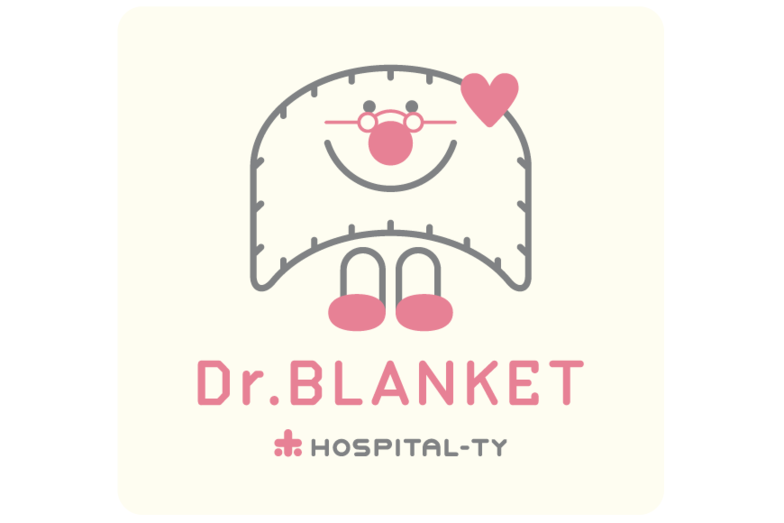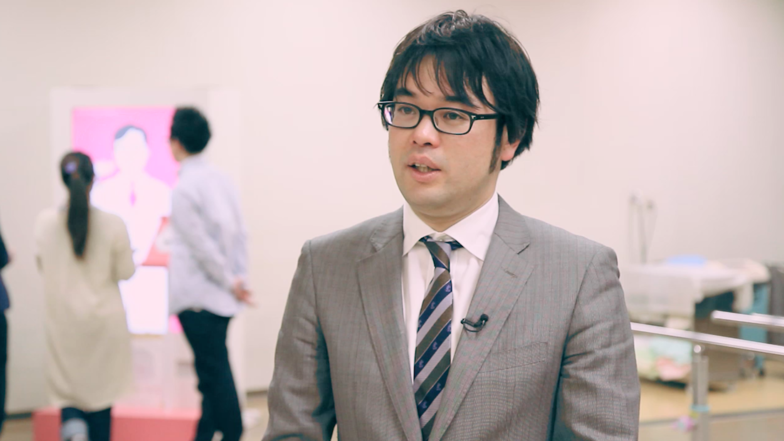Enter the Knee Blanket Teacher (Tsubasa Adachi)
Hello, I'm Tsubasa Adachi, an art director. I handle art direction for the "Hospitality Project," which solves various hospital challenges through "hospitality." In previous articles, copywriter Yukio Hashiguchi introduced digital solutions like "Disinfection Sensei"and "High-Five Sensei." This time, I'll introduce an analog "Sensei" different from the digital ones we've seen so far.
Mihara Memorial Hospital treats many patients, from those with neurological diseases like Parkinson's to those with lifestyle-related illnesses like hypertension. Like other hospitals, long outpatient wait times are a problem. With an average of 115.8 outpatients per day, the average wait time was about 1 hour and 15 minutes.
We observed the waiting room, where many patients looked tired while waiting their turn. However, it's not possible to suddenly add more doctors or examination rooms. We wondered: What could we do in terms of "hospitality"?

Dr. Knee Blanket's Logo

Patients tackling Dr. Knee Blanket's quiz in the waiting room
Mihara Memorial Hospital specializes in neurological disorders, primarily stroke. For patients, the brain and nervous system are major concerns. We therefore wanted to provide quizzes that would activate their brains enjoyably while they waited.
But that alone felt insufficient for hospitality. Observing the waiting room, we noticed elderly patients and women often brought and used their own "lap blankets." This gave us the idea: provide free lap blankets printed with quizzes. Thus was born "Knee Blanket Sensei," warming both body and brain.
But "brain-activating quizzes"? We knew nothing about them!! Developing them was tough. We interviewed experts multiple times and pored over thick reference books. One discovery was "ambiguous figures" – pictures or shapes that can be interpreted in two or more ways depending on your perspective.

Rubin's Vase

Idea Memo
You know how there's the Rubin Vase, where focusing on the white background shows two facing profiles, while focusing on the black background shows a vase? Switching your perspective like this is said to have a positive effect on the brain.
Based on this concept, I designed the quiz above. Focus on the gray background and the characters "我中" (self-centered) appear; focus on the white background and the characters "無夢" (dreamless) appear. The answer is the four-character idiom "無我夢中" (self-forgetful).
Beyond this, we've prepared a total of 10 different quizzes to keep you engaged even during long waits. A university professor researching neuroscience commented that "stimulation of the prefrontal cortex is expected."
We selected a soft, brushed fabric for a comfortable feel, making it pleasant to use as a lap blanket. It's placed in the waiting room for patients to use freely. We hope it keeps bodies warm, minds active, and the relationship between the hospital and patients warm too!
This is the final installment of the Hospitality series. We spoke with Mr. Gen Mihara, Director of the Corporate Headquarters at Mihara Memorial Hospital, about this Hospitality project.
Mr. Gen Mihara's Thoughts on Hospitality

Mihara Memorial Hospital Corporate Headquarters, Director Gen Mihara
—Why did you choose to consult with Dentsu Inc.?
As we face a super-aged society, integrated community care is being advocated, but crucially, we haven't gained sufficient understanding and cooperation from the general public.
Furthermore, Mihara Memorial Hospital had earned high regard within the medical community, ranking first nationally among 1,505 hospitals in the 2012 "Functional Evaluation Coefficient" (a Ministry of Health, Labour and Welfare DPC [Diagnosis Procedure Combination] functional evaluation for acute care wards). We also wanted to appeal to the general public next.
The medical field is often perceived as insular, so seeking advice from other industries might help us discern patients' hidden needs. Looking beyond the confines of medical conventions and preconceptions will become increasingly vital for hospital management going forward.
—What are your thoughts on the concept of "Hospitality"?
I found the concept of "hospital hospitality" expressed in new terminology to be very clear. For healthcare professionals, how to get patients to cooperate with treatment is an eternal theme. Creating a system that makes things happen naturally, rather than relying on the common approach of persuading and convincing patients, is a fresh perspective and a truly eye-opening idea.
Historically, hospitals were seen as special environments occupied only during treatment, with patients returning to society once their needs were met. However, medical advances now allow people to live in society while managing health issues with ongoing medical and nursing support. Making healthcare feel accessible in everyday life has become crucial. This initiative seems to offer one answer to the challenge of bridging the two disconnected worlds of healthcare and society.
Japan is leading the world into a super-aged society. The entire world is watching how Japan will tackle this challenge. While Japan has historically modeled its healthcare system after the American model, there is now no system to simply replicate. In these difficult circumstances, I believe it would be a great honor if Japan could adapt to changing social realities by leveraging its strength: the spirit of hospitality.
—How did you announce the project when it started?
We explained it to staff during morning meetings, various committees, and via the intranet and email. To ensure patients also understand, when it was featured in newspapers or on TV, we posted announcements on hospital bulletin boards and our website. We also placed explanatory posters about hospitality in the most prominent location at the hospital entrance.

Posting the Hospitality Project poster throughout the hospital
—How did people inside and outside the hospital react?
Regarding the High-Five Teacher poster, the teacher who served as the model said it captured characteristics they hadn't realized about themselves, and they felt a bit conflicted about it (laughs).
There was also feedback suggesting we shouldn't stop after these three initiatives, but make this an ongoing effort. For example, we could solicit ideas from staff every year and adopt the best ones.
We've also received feedback not just from patients, but from their families too, saying the hospital used to have a gloomy image, but now it feels brighter. Hospitality might actually help make hospitals more open places within the community.
As community development centered around hospitals becomes increasingly important, we want hospitaltiy to be more than just public relations—we want it to play a role in integrating healthcare into society.
The Future of Hospitality (Yukio Hashiguchi)
We were fortunate that everything from identifying the challenge to execution was advanced through our partnership with Mihara Memorial Hospital. When tackling new challenges, collaborating beyond the typical client-agency framework can unleash even greater potential.
Additionally, developing devices for the medical field was a first for us, and applying our art direction and copywriting expertise proved highly valuable. The insight-driven approach seen in advertising creatives complements the technology-driven approach, filling gaps and creating a strong synergy. This reaffirmed my belief that advertising creators should actively expand into digital and technology domains.
Rising healthcare costs are a societal problem. Solving this requires pooling wisdom from diverse fields, not just medical professionals. Hospitality initiatives should offer many avenues for contribution. We aim to actively develop new ideas, using these three case studies as a starting point.
For details about the Knee Blanket Teacher or Hospitality, please contact ぜひhospital-ty@dentsu.co.jp (Adachi, Hashiguchi, Kanasaka).












